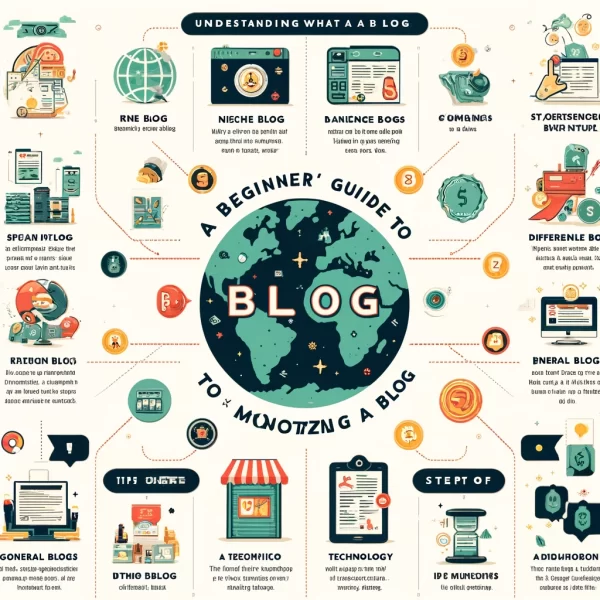
Contents
- Understanding What a Blog Is
- Different Types of Blogs:
- Choosing the Right Domain Name
- Comparison of Faceless Blogs vs. Personal Brand Blogs:
- Examples to Illustrate the Impact of Each Type on Branding:
- Selecting a Hosting Service
- Benefits of Choosing HostGator for WordPress Hosting:
- Setting Up Your Blog with HostGator
- Step-by-Step Guide on Signing Up with HostGator:
- How to Install WordPress on HostGator:
- Selecting a WordPress Theme and Customizing Your Blog:
- Content Creation for Your Blog
- Strategies for Consistent and Engaging Content Creation:
- Importance of Content Quality and Quantity:
- How Often to Post New Content to Stay Relevant:
- Monetization Strategies
- Overview of Different Ways to Make Money from a Blog:
- Tips for Successful Blog Monetization:
- Increasing Blog Traffic
- Importance of SEO (Search Engine Optimization) in Writing and Structuring Posts:
- Using Social Media to Enhance Blog Visibility and Drive Traffic:
- Importance of High-Quality Backlinks and Networking with Other Bloggers:
- Using Analytics to Track and Improve:
- Conclusion
Blogging is one of the most dynamic and profitable online ventures in the digital era. Unlike traditional media, blogging offers individuals a platform to share their insights, expertise, and stories with a global audience.
Whether it’s through niche content aimed at specific audiences or broader topics designed to appeal to general readers, the potential to turn a blog into a source of income has never been more accessible.
However, the path to becoming a successful blogger is not just about writing and posting content. It involves understanding the foundational elements of the digital landscape, including technical setup, content strategy, and monetization techniques.
Beginners often overlook these essentials, which are crucial for turning a casual blogging hobby into a sustainable revenue-generating business.
In this guide, we will walk you through the critical steps to not only start a blog but also to monetize it effectively. From selecting the right domain name and hosting service to crafting engaging content and implementing various income streams, understanding these basics will provide you with the tools you need to launch and grow a profitable blog.
Understanding What a Blog Is
Definition of a Blog: A blog is a type of website where content is presented in a conversational style and is regularly updated. Originating as personal online diaries, blogs have evolved into platforms that can include personal, professional, and even corporate insights.
Typically, each post is displayed in reverse chronological order, ensuring the freshest content greets the visitor first. Blogs can be about any subject and can include text, images, videos, and links to other blogs and web pages.
Different Types of Blogs:
Niche vs. General Blogs: Blogs can broadly be categorized into two types: niche blogs and general blogs. Each type serves a different purpose and attracts different audiences.
- Niche Blogs: Niche blogs focus on specific topics, offering detailed insights and expertise in a particular area. Examples include blogs dedicated to personal finance, vegan cooking, digital marketing, or even more narrow focuses such as drone racing technology or Scandinavian interior design. The key advantage of a niche blog is the ability to attract a highly targeted audience who are deeply interested in the subject matter. This can lead to higher engagement rates, more consistent traffic, and better monetization opportunities through tailored affiliate programs and advertisements.
- General Blogs: General blogs cover a broad range of topics and do not restrict themselves to a single niche. They might feature categories like technology, lifestyle, health, and entertainment all under one roof. The diversity of content can attract a wider audience but may face challenges in establishing a loyal readership due to the lack of focus. Monetizing a general blog can be more complex, as advertisers may be hesitant to invest without a clear, targeted audience. However, they offer flexibility and the potential to pivot between topics based on trends and personal interests.
Deciding between a niche and a general blog largely depends on your personal interests, expertise, and the audience you aim to attract. If you are passionate about a specific subject and enjoy deep dives into topics, a niche blog might be right for you. On the other hand, if you have a wide range of interests and prefer writing about various topics, a general blog could offer the creative freedom you desire.
Choosing the Right Domain Name
Importance of a Domain Name in Branding: A domain name is crucial in establishing the identity of your blog. It acts as the digital address that visitors use to find your content and plays a significant role in shaping first impressions. A well-chosen domain name not only reinforces your brand’s message but also enhances its memorability and credibility. In the digital marketplace, where competition for attention is fierce, having a domain name that reflects the essence of your brand can make a significant difference in attracting and retaining readers.
Comparison of Faceless Blogs vs. Personal Brand Blogs:
- Faceless Blogs: Faceless blogs use a generic or brand-centric domain that doesn’t identify the blog owner personally. These are typically focused on a particular subject matter or industry rather than an individual’s personality.
- Pros:
- Flexibility in ownership, making it easier to sell the blog in the future.
- Allows for broader content coverage without being tied to a personal brand.
- Offers privacy and separation between the blog owner’s personal and professional life.
- Cons:
- May struggle to create a strong personal connection with the audience.
- Requires more effort to build brand loyalty and recognition without a personal story.
- Pros:
- Personal Brand Blogs: These blogs incorporate the owner’s name within the domain and are closely linked to the individual’s identity, showcasing personal insights, expertise, and experiences.
- Pros:
- Facilitates a strong personal connection and loyalty with the audience.
- Ideal for professionals looking to establish themselves as thought leaders in their niche.
- Enhances the authenticity and uniqueness of the blog’s content.
- Cons:
- Difficult to separate or sell the blog as it is closely tied to the individual’s identity.
- Less flexibility in changing content focus or blog direction without impacting brand perception.
- Pros:
Examples to Illustrate the Impact of Each Type on Branding:
- Faceless Blog Example: Imagine a blog with the domain “TechTrendsToday.com.” This name suggests a focus on current technology trends and news, appealing to tech enthusiasts without revealing any personal information about the blogger.
This approach allows multiple contributors and flexibility in content management and ownership. - Personal Brand Blog Example: Consider “AliciaCooks.com.” This domain clearly indicates that Alicia is sharing her personal culinary experiences and recipes. The domain helps build a personal connection with her audience, who may be drawn to her unique cooking style and personality.
This type of blog is particularly effective for building a personal brand and connecting with followers on a more personal level.
When choosing a domain name, consider visiting a domain registration site like GoDaddy to explore available options that align with your blog’s vision and branding strategy. GoDaddy provides a wide range of domain names that can cater to both faceless and personal brand blogs, offering tools and services to help you secure the perfect domain name for your blogging journey.
Choosing the right domain name is a foundational step in your blogging career. Whether you opt for a faceless brand that allows for broad content creation and privacy, or a personal brand that fosters deep connections with your audience, the key is to select a name that resonates with your content, aligns with your branding strategy, and appeals to your target audience.
I use HostGator for my hosting and love it, there are lots of hosting services out there, and I will give 2 examples.
Selecting a Hosting Service
Importance of Choosing a Reliable Hosting Service: Choosing a reliable hosting service is crucial for the stability and performance of your blog. A good hosting provider ensures that your blog remains accessible to your audience around the clock, maintains fast load times, and can handle sudden spikes in traffic without any disruptions.
The right host can also offer essential support and robust security features that protect your site from online threats. The quality of your hosting service significantly impacts your blog’s search engine optimization (SEO); search engines favor websites that load quickly and are secure, which can enhance your blog’s visibility and ranking.
Detailed Introduction to HostGator: HostGator is a well-regarded web hosting provider known for its dependable service, scalability, and excellent customer support. Since its establishment in 2002, HostGator has become a go-to host for both novice bloggers and experienced website owners.
They offer a range of hosting solutions, including shared hosting, VPS hosting, dedicated servers, and managed WordPress hosting plans, making it a versatile option suitable for blogs of all sizes and scopes.
Benefits of Choosing HostGator for WordPress Hosting:
- Simplicity and Accessibility: HostGator offers an intuitive control panel that facilitates easy installation of WordPress, allowing bloggers to get their site operational in just a few clicks.
- Reliability and Uptime: HostGator promises a 99.9% uptime guarantee, ensuring your blog is reliably online and available to visitors.
- Scalability: With HostGator, you can start with a basic plan and upgrade to more robust hosting options as your blog grows, without experiencing downtime or other technical issues.
- Advanced Security: HostGator provides automatic malware removal, and their custom firewall rules help safeguard your blog from potential security threats.
- Comprehensive Customer Support: They offer 24/7 support through multiple channels, including phone, live chat, and email, backed by a wealth of online resources for troubleshooting and learning.
Promotional Offers are Typically Available: These offers often include discounts such as a reduced rate for the first year of hosting, complimentary domain registration, or free SSL certificates, which are vital for securing your site.
For those who might consider alternative options, Bluehost is another excellent hosting provider that offers specialized WordPress hosting services. Similar to HostGator, Bluehost provides a user-friendly experience, robust security measures, and excellent customer support, making it another top choice for bloggers looking to start on a strong foundation.
In selecting a hosting service like HostGator or Bluehost, you are laying down a solid foundation for your blog’s success. These services not only ensure your blog operates efficiently and securely but also support its growth trajectory through scalable solutions and ongoing technical support.
Setting Up Your Blog with HostGator
Starting a blog can seem daunting, but with a hosting service like HostGator, the process is simplified. Here’s a step-by-step guide to help you sign up with HostGator, install WordPress, and choose the perfect theme for your blog.
Step-by-Step Guide on Signing Up with HostGator:
- Choose Your Hosting Plan: HostGator offers various hosting plans including shared, VPS, and dedicated hosting. For most new bloggers, a shared hosting plan is adequate and cost-effective. Visit the HostGator website and select the plan that best fits your needs.
- Register a Domain Name: If you haven’t already registered a domain name, you can do so directly through HostGator during the sign-up process. Alternatively, if you already own a domain name, you can transfer it to HostGator or simply update your domain’s DNS settings to point to your new HostGator hosting account.
- Complete Your Order: Fill out the registration form with your personal and billing information. HostGator often offers promotional codes for new customers, so make sure to apply any relevant discounts during checkout.
- Set Up Your Hosting Account: Once your purchase is complete, HostGator will send you an email with your control panel (cPanel) login information. This is where you manage your hosting account and install WordPress.
How to Install WordPress on HostGator:
- Access Your cPanel: Log into your HostGator cPanel using the credentials provided. The cPanel is a web-based hosting control panel that provides tools to manage your hosting account.
- Install WordPress: Navigate to the “Software” section in your cPanel and click on ‘QuickInstall’ or ‘Softaculous Apps Installer’—HostGator’s one-click installation services. Select WordPress from the list of applications.
Choose the domain where you want to install WordPress, fill in the necessary fields such as site name, admin username, and password, and then click on the ‘Install’ button. - Wait for Installation to Complete: The installation process may take a few minutes. Once it’s complete, you will receive a confirmation with your WordPress admin panel URL (typically yourdomain.com/wp-admin), username, and password.
Selecting a WordPress Theme and Customizing Your Blog:
- Access Your WordPress Dashboard: Navigate to your WordPress admin panel by entering the URL provided after installation. Log in using the credentials you set up during the WordPress installation.
- Choose a Theme: Click on ‘Appearance’ and then ‘Themes’ in your WordPress dashboard. You can choose from thousands of free and premium themes available. Browse through the themes, preview them, and install the one that best suits the style and functionality you desire for your blog.
- Customize Your Theme: After installing your chosen theme, click on ‘Customize’ under the ‘Appearance’ menu to start tailoring your theme to your preferences. Here, you can modify various aspects such as the color scheme, font styles, header layout, and more. You can also set up widgets, menus, and even add custom CSS to enhance your blog’s design.
- Create Essential Pages and Write Your First Post: Don’t forget to create essential pages such as ‘About,’ ‘Contact,’ and ‘Privacy Policy.’ Once those are set, you’re ready to start blogging! Create your first post by navigating to ‘Posts’ > ‘Add New’ in your WordPress dashboard, and begin sharing your thoughts, insights, or stories.
Setting up your blog with HostGator and WordPress is straightforward, and you don’t need any technical expertise to get started. With a user-friendly interface and powerful customization options, you’ll be able to focus on creating content and growing your blog.
Content Creation for Your Blog
Creating content for your blog involves more than just writing about topics you’re passionate about. Strategic content creation can boost engagement, improve SEO, and keep your audience coming back for more.
Here’s how to develop content that resonates with your audience and maintains consistency in quality and frequency.
Strategies for Consistent and Engaging Content Creation:
- Plan Your Content: Start by creating a content calendar. This can be a simple spreadsheet or a detailed plan using tools like Trello or Asana. Outline topics, key dates, and publication deadlines. Planning ahead helps in maintaining a steady flow of content and prevents last-minute scrambles for ideas.
- Understand Your Audience: Knowing who you are writing for is crucial. Use tools like Google Analytics to gain insights into your audience’s demographics and preferences. This information can guide the type of content you produce, ensuring it appeals to the interests, needs, and challenges of your readers.
- Incorporate a Variety of Content Types: While blog posts are essential, diversifying your content can engage different parts of your audience. Include videos, podcasts, infographics, and interviews. This variety can refresh your blog and attract more visitors.
- Leverage AI Tools like ChatGPT: Utilize advanced AI tools such as ChatGPT to assist with generating ideas, creating draft outlines, or even writing initial content drafts. ChatGPT can help overcome writer’s block and provide a fresh perspective on topics, making your content creation process more efficient and diverse.
- Use SEO Best Practices: Optimize your content for search engines. Research and integrate relevant keywords, use meta tags effectively, and ensure your website has a responsive design. SEO-friendly content will help increase your blog’s visibility and organic traffic.
Importance of Content Quality and Quantity:
- Quality Over Quantity: While it’s important to keep your blog updated regularly, quality should never be sacrificed for the sake of quantity. High-quality content is engaging, well-researched, and provides value, which increases the likelihood of shares and return visits.
- Maintain a High Standard: Ensure that all content is well-written, thoroughly edited, and fact-checked. Poor grammar or inaccurate information can damage your blog’s credibility.
How Often to Post New Content to Stay Relevant:
- Find Your Ideal Frequency: The frequency of posts will depend on your niche, audience, and personal capacity. Some successful blogs post daily, while others post once a week and still maintain a strong following. Analyze your audience’s engagement and experiment to find what works best for you.
- Consistency is Key: More important than frequency is consistency. If your readers expect a new post every Tuesday, make sure you deliver. This regularity helps build a loyal audience and can boost your SEO performance.
- Schedule and Automate: Use tools like WordPress’s scheduling feature to automate the posting process. This can help in maintaining consistency, especially during busy periods or when you are unable to post manually.
Content creation is not just about filling your blog with articles; it’s about crafting valuable experiences that resonate with your audience. By focusing on quality, engaging diverse content types, and maintaining a consistent posting schedule, you can enhance your blog’s impact and reach. Remember, the most successful bloggers can connect with their readers through compelling content, consistently delivered.
Monetization Strategies
Turning your blog into a revenue-generating platform is an exciting step. There are multiple ways to monetize a blog effectively, from advertising to selling products and affiliate marketing. Here’s a comprehensive overview of these strategies and tips on implementing them successfully.
Overview of Different Ways to Make Money from a Blog:
- Advertising: Advertising is one of the most common ways to earn revenue from a blog. Platforms like Google AdSense allow you to display ads on your blog and earn money either through clicks (CPC) or impressions (CPM). Setting up AdSense is straightforward, and it can start generating income as soon as your blog begins to receive traffic.
- Selling Products: Many bloggers turn to selling products as a direct way to monetize their audience. These can be:
- Physical products: Anything from branded merchandise to books and handcrafted goods. If your blog has a dedicated following, selling branded items can be a lucrative option.
- Digital products: E-books, courses, printables, or software. Digital products have high margins and can be sold worldwide with minimal overhead costs.
- Affiliate Marketing: Affiliate marketing involves promoting other people’s products and earning a commission for each sale made through your unique affiliate link. It’s a powerful way to generate income if you can align the products you promote with the interests of your audience.
- Starting with Affiliate Marketing: Choose affiliate programs that match your niche. For instance, if your blog is about technology, you might want to join affiliate programs for tech gadgets or software. If you previously promoted Hostinger, consider switching to HostGator for web hosting recommendations. HostGator often offers attractive commission structures and is well-regarded in the hosting industry.
- Benefits of Affiliate Marketing: Affiliate marketing is appealing because it doesn’t require you to create your own products. It can be less risky and offers the potential for significant income, especially if you have a large or very engaged audience. Additionally, it’s scalable; more traffic and better conversions directly increase your earnings.
- Integrating Affiliate Links Naturally into Content: Always aim to include affiliate links organically within your content. For example, if you are writing a tutorial on starting a blog, you can link to HostGator’s hosting services where relevant. Ensure that your content provides value first; the affiliate links should enhance the information you are providing rather than detract from it.
Tips for Successful Blog Monetization:
- Transparency with Your Audience: Always disclose your use of affiliate links to maintain transparency with your readers. This builds trust and complies with advertising standards.
- Quality Over Quantity: When it comes to affiliate marketing and ads, less can be more. Too many ads or affiliate links can be off-putting and may degrade the quality of the user experience on your blog.
- Monitor and Optimize: Use analytics to track which monetization strategies work best for your blog. Experiment with different types of ads, affiliate products, or e-commerce strategies to find what yields the best results.
By employing a mix of these monetization strategies, you can maximize the revenue potential of your blog. Whether it’s through ads, selling products, or affiliate marketing, each method has unique benefits and can be tailored to suit the needs of your blog and your audience.
Increasing Blog Traffic
Growing your blog’s audience is essential for increasing its impact and monetization potential. Here are key strategies to help you boost traffic effectively:
Importance of SEO (Search Engine Optimization) in Writing and Structuring Posts:
- Keyword Optimization: Identify and target specific keywords that your audience is searching for. Use tools like Google Keyword Planner or SEMrush to find relevant keywords. Incorporate these keywords naturally into your titles, headers, and body text to improve your posts’ visibility in search results.
- On-Page Optimization: Ensure that each post is optimized for SEO best practices. This includes using meta descriptions, alt tags for images, and proper URL structures. Also, make sure your blog is mobile-friendly, as this significantly affects search rankings.
- Content Quality: Search engines favor content that is not only keyword-rich but also valuable and engaging for readers. High-quality, comprehensive content tends to rank higher and attract more organic traffic.
Using Social Media to Enhance Blog Visibility and Drive Traffic:
- Active Engagement: Utilize platforms like Facebook, Twitter, Instagram, and Pinterest to share your content and engage with your audience. Tailor your posts to fit the unique style of each platform and use relevant hashtags to increase your reach.
- Consistent Posting: Maintain a regular posting schedule to keep your audience engaged. Tools like Buffer or Hootsuite can help schedule posts across multiple platforms simultaneously.
- Community Interaction: Participate in online communities related to your blog’s niche. Answer questions, provide value, and share relevant content to drive interested users back to your blog.
Importance of High-Quality Backlinks and Networking with Other Bloggers:
- Guest Posting: Contribute guest posts to other reputable blogs in your niche. This not only provides high-quality backlinks but also exposes your blog to a broader audience.
- Collaborations: Collaborate with other bloggers or influencers to co-create content. This mutual promotion benefits all parties involved and can significantly boost traffic.
Using Analytics to Track and Improve:
- Google Analytics: Set up Google Analytics to monitor your blog’s traffic, user behavior, and engagement metrics. This tool provides insights into which content performs best and where your traffic is coming from.
- Adjusting Strategies Based on Analytics Data: Regularly review your analytics to understand what is working and what isn’t. Use this data to refine your content strategy, improve SEO tactics, and optimize your social media outreach for better performance.
Conclusion
Recapping the essential steps to starting and monetizing a blog includes understanding the basics of blogging, selecting a reliable hosting service like HostGator, engaging in effective content creation, and implementing diverse monetization strategies. Continuous learning and adapting to new trends and analytics insights are crucial for long-term success.
Now is the perfect time to embark on your blogging journey. Equip yourself with the recommended tools and strategies discussed, and leverage platforms like HostGator for hosting solutions. Explore further resources and detailed guides available through affiliate links provided here, and take the first step towards building a successful blog. Your dedication and persistence will be key to your growth and success in the blogging world.
Ready to start your blog? Check out HostGator for reliable hosting options and Google Analytics to track your blog’s performance as you grow.
Tags: affiliate marketingblog trafficbloggingcontent creationdigital marketingGoogle AnalyticsHostGator hostingmonetize a blogonline businessSEO tipssocial media marketingstart a blog







